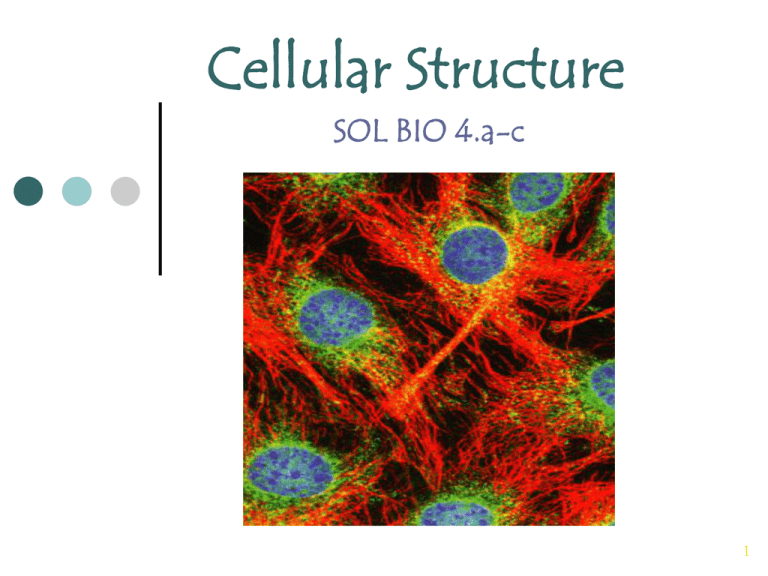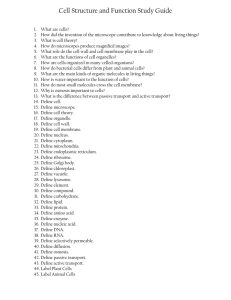Cell Structure
advertisement

Cellular Structure SOL BIO 4.a-c 1 Cell Theory The cell theory is the unifying theme in biology because it emphasizes the similarity of all living things. All organisms are composed of one or more cells. Cells are the smallest living units of all living organisms. Cells arise only by division of a previously existing cell. 2 Cell Characteristics Cells contain specialized structures to perform functions necessary for life. Cellular activities necessary for life include chemical reactions that facilitate: acquiring energy reproduction adaptation maintaining homeostasis 3 Cell Characteristics The basic processes necessary for living things to survive are the same for a single cell as they are for a more complex organism. A single-celled organism has to conduct all life processes by itself. A multi-cellular organism has groups of cells that specialize to perform specific functions. 4 Cell Characteristics All cells contain: Genetic material single circular molecule of DNA in prokaryotes double helix located in nucleus in eukaryotes Cytoplasm jelly-like substance that fills the cells interior Phospholipids Plasma membrane encloses the cell – phospholipid bilayer Membrane proteins 5 Cell Types Cell structure is one of the ways in which organisms differ from each other. 2 Types of Cells •Prokaryote •Eukaryote 6 Prokaryotic Cells Earth’s first cells were prokaryotes. The simplest life forms are the prokaryotes. Prokaryotic cells exist in two major forms: eubacteria and archaebacteria. 7 Prokaryotic Cells Prokaryotes are the Earth’s most abundant inhabitants. They can survive in a wide range of environments and obtain energy in a variety of ways. 8 Prokaryotic Cells Prokaryotes are cells that lack a nucleus and membrane bound organelles. Bacteria and related microorganisms are prokaryotes 9 Prokaryotic Cells Some use flagellum for locomotion ALL are UNICELLULAR Bacterial cell wall Rotary motor Flagellum Sheath 10 Generalized Prokaryotic Cell 11 Eukaryote • Eukaryotes arose from prokaryotes and developed into larger more complex organisms. • Eukaryotes are cells that contain a nucleus and organelles surrounded by a membrane, such as mitochondria and chloroplasts. 12 Eukaryote • Can be both unicellular or multi-cellular • Examples of eukaryotes are: • All fungus, plant, and animal cells 13 Generalized Eukaryotic Cell 14 Cell Size Most cells are relatively small because as size increases, volume increases much more rapidly. longer diffusion time 15 Visualizing Cells 16 Nucleus Stores genetic material Contains DNA site where RNA is made Nucleolus: Chromatin and ribosomal subunits Nuclear envelope: Double membrane with pores Largest organelle BRAIN of the cell – controls protein synthesis 17 Nucleus 18 Nucleus 19 Nucleus 20 Ribosomes Ribosomes are RNA-protein complexes composed of two subunits that join and attach to messenger RNA. site of protein synthesis assembled in nucleolus 21 Ribosomes They can be found alone in the cytoplasm or attached to the endoplasmic reticulum. Alone in cytoplasmmakes proteins for use within the cell Attached to RER- makes proteins for export out of the cell 22 Ribosomes 23 Endoplasmic reticulum transports materials through the cell •Rough ER - studded with ribosomes •Attached to nuclear membrane •site of protein synthesis and processing •Smooth ER - lacks ribosomes •site of synthesis of phospholipids and the packaging of proteins into vesicles 24 Endoplasmic reticulum 25 Endoplasmic reticulum 26 Golgi apparatus collection of Golgi bodies •Stacked flattened sacks •Site where cell products are packaged for export • Proteins are modified by being combined with fats or carbohydrates 27 Golgi apparatus Vesicles then pinch off from the Golgi body to be secreted (outside the cell) Involved in the production of lysosomes 28 Golgi apparatus 29 Copyright © The McGraw-Hill Companies, Inc. Permission required for reproduction or display. Golgi apparatus Proteins Transport vesicle Golgi apparatus Protein Ribosome Migrating Vesicle transport Fusion budding from rough vesicle of vesicle with Golgi endoplasmic apparatus reticulum 30 Lysosomes vesicles produced by the Golgi apparatus. Lysosomes contain digestive enzymes and are involved in intracellular digestion of food particles, disease causing bacteria and worn out cell parts 31 Copyright © The McGraw-Hill Companies, Inc. Permission required for reproduction or display. 32 Copyright © The McGraw-Hill Companies, Inc. Permission required for reproduction or display. Cytoplasm Endoplasmic reticulum Food vesicle Golgi apparatus Lysosomes Plasma membrane Extracellular fluid Digestion of food particles or cells Transport vesicle Old or damaged organelle Breakdown of old organelle 33 Vacuoles Found in PLANT and ANMAL cells The vacuole acts a container, storing water and dissolved particles Plants have a large central vacuole for water storage Unicellular animals can use contractile vacuoles for movement 34 Organelles With DNA Mitochondria site of cell respiration Chloroplasts site of photosynthesis 35 Mitochondria "Powerhouse of the cell" - cellular metabolism Structure- outer and inner membranes, cristae Found in both plant and animal cells Very active cells have more mitochondria 36 Chloroplasts •Chloroplasts are larger and more complex than mitochondria •Contain green pigment called chlorophyll that absorbs sunlight in the first step of photosynthesis •Found ONLY in PLANTS 37 Cell Membrane •controls what enters and leaves the cell •Found in ALL cells •Phospholipid bilayer with transport proteins, and cholesterol (for flexibility) 38 39 Cell Wall •provides support •Found in PLANT and BACTERIA cells •Made from cellulose 40 41 Cytoskeleton Long slender protein tubes and fibers that extend from the nucleus to the plasma membrane. The cytoskeleton contains three types of elements responsible for cell shape, movement within the cell, and movement of the cell: Actin filaments Microtubules Intermediate filaments 42 Cytoskeleton The cytoskeleton contains three types of elements : Actin filaments 43 Cytoskeleton The cytoskeleton contains three types of elements: Microtubules 44 Cytoskeleton The cytoskeleton contains three types of elements: Intermediate filaments 45 Cytoskeleton 46 Centrioles •Cylindrical structures found near the nucleus •Made of hollow, tubular structures arranged in bundles •Important in cell division •Found ONLY in ANIMAL cells 47 48 Plant vs. Animal Cells PLANT CELL HAVE: Cell Wall LARGE vacuoles Chloroplasts DO NOT HAVE: Centrioles ANIMAL CELL Cell membrane Mitochondria HAVE: Golgi apparatus Centrioles Nucleus Cytoskeleton DO NOT HAVE: Ribosomes Cell Wall Endoplasmic LARGE vacuoles reticulum Chloroplasts Lysosomes 49 50 Plant Cell 51 52 53 54 Endosymbiosis Endosymbiosis theory suggests that eukaryotes arose from a symbiotic relationship between various prokaryotes. Heterotrophic bacteria became mitochondria. Cyanobacteria became chloroplasts. Host cell was a large eukaryotic cell. 55 Endosymbiosis Prokaryotic cell is engulfed Eukaryotic cell Symbiosis Prokaryotic cell 56 ta_03_14 Evolution of the eukaryotic cell Slide number: 2 plasma membrane 57 Copyright © The McGraw-Hill Companies, Inc. Permission required for reproduction or display. ta_03_14 Evolution of the eukaryotic cell Slide number: 3 plasma membrane endoplasmic reticulum nucleus nuclear envelope Cell has a nucleus and other organelles. 58 Copyright © The McGraw-Hill Companies, Inc. Permission required for reproduction or display. ta_03_14 Evolution of the eukaryotic cell Slide number: 4 aerobic bacterium plasma membrane endoplasmic reticulum nucleus nuclear envelope Cell has a nucleus and other organelles. Cell has mitochondria. 59 Copyright © The McGraw-Hill Companies, Inc. Permission required for reproduction or display. ta_03_14 Evolution of the eukaryotic cell Slide number: 5 aerobic bacterium plasma membrane spirochete Animal cell has a flagellum. endoplasmic reticulum nucleus nuclear envelope Cell has a nucleus and other organelles. Cell has mitochondria. 60 Copyright © The McGraw-Hill Companies, Inc. Permission required for reproduction or display. ta_03_14 Evolution of the eukaryotic cell Slide number: 6 aerobic bacterium plasma membrane spirochete Animal cell has a flagellum. endoplasmic reticulum nucleus nuclear envelope cyanobacterium Cell has a nucleus and other organelles. Cell has mitochondria. Plant cell has chloroplasts. 61 Copyright © The McGraw-Hill Companies, Inc. Permission required for reproduction or display. Cell Differentiation Cell specialization occurs during the development of a multi-cellular organism. The genetic information necessary for all cellular functions remains in each cell but may not be used. 62




